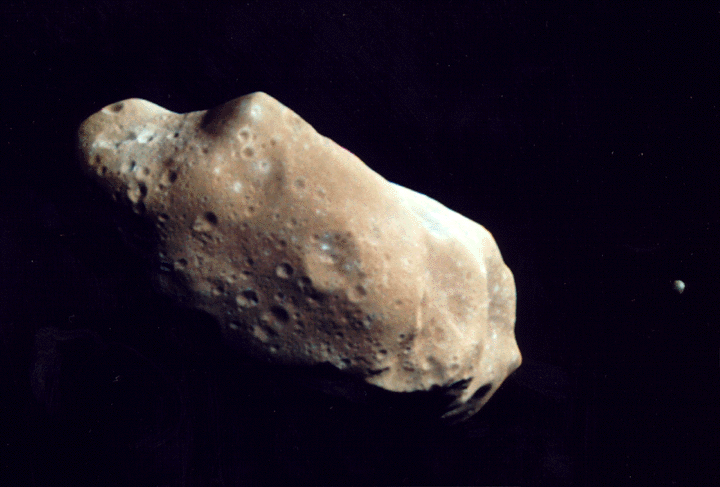
Caption: Asteroid 243 Ida and its moon Dactyl.
Features:
- This is a false-color
image of Ida taken on a
flyby by the
Galileo spacecraft (1989--1995-arrival--2003)
on its way to Jupiter.
It was just a fortuitous coincidence that Ida was on the trajectory of the Galileo spacecraft (19891995-arrival--2003).
- The colors were chosen to indicate possible differences in surface composition.
Blue may indicate iron bearing
minerals.
- North on Ida is at 1:00 o'clock
(in clock position).
But does this mean north on the celestial sphere
or north as the axis of rotation with the direction of rotation given by
a right-hand rule?
The NASA caption doesn't say, but I suspect the later.
- Ida,
like most smaller asteroids, is NOT round.
Its self-gravity
is insufficient to pull it into a spherical shape against the
rigid-body electromagnetic force
of its solid materials and the
centrifugal force due to its rotation.
- There are still relatively asteroids that have
been imaged up close.
But we certainly have lots images of those asteroids
that have intentionally visited by spacecraft:
e.g., 1 Ceres ⚳,
4 Vesta ⚶,
and
433 Eros
(see
Wikipedia:
List of minor planets that have been visited by spacecraft).
The number visited asteroids will probably increase with time.
Image link/download site: NASA: Galileo spacecraft (1989--1995-arrival--2003): Image #P-44131.
Local file: local link: 243_ida.html.
File: Asteroid file: 243_ida.html.